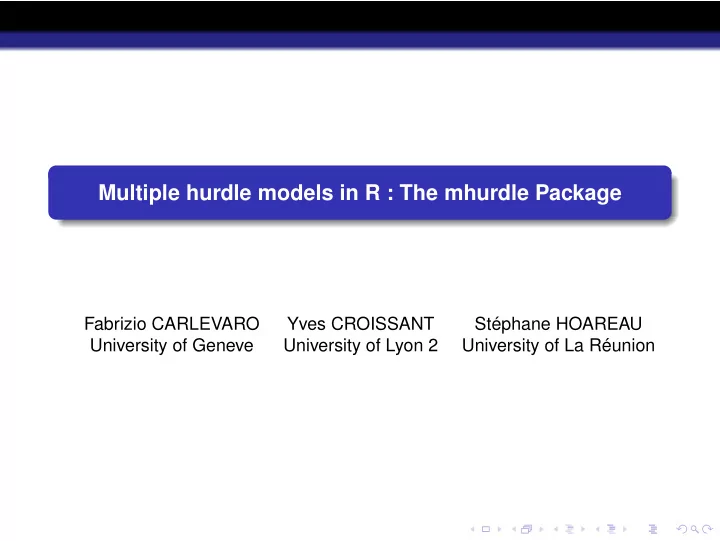

Multiple hurdle models in R : The mhurdle Package Fabrizio CARLEVARO Yves CROISSANT Stéphane HOAREAU University of Geneve University of Lyon 2 University of La Réunion logo2
����������������������� ���������������� ����� � ����� �!��������"!�#���"�!��� ��������������������������� ������������������ ��$���#������ �������%��#��!��� logo2
���������� �������������������������������������������� ������������������������������������������������ �������������������������������������������� ��$�!#�$%�&����$��&�� )�#������ ��� �!"� %!!'�#�"����� �$"#�*��$�+� #��!�#���� ������������ ��������,������(��� $������������������� ��������(��������� ��������(��������� logo2
Seminal papers Single equation models Model Author censoring mechanism Tobit Model T OBIN (1958) Lack of resources C RAGG (1971) Single hurdle model Good refusal Double hurdle model C RAGG (1971) Good refusal and B LUNDELL (1987) lack of resources P-Tobit model D EATON and I RISH (1984) Purchase infrequency and lack of resources Systems of demand equations Author censoring mechanism W ALES and W OODLAND (1982) Lack of resources H ANEMANN (1984) Good refusal R OBIN and M EGHIR (1992) Purchase infrequency B OIZOT , R OBIN and V ISSER (2001) Purchase infrequency logo2
A comprehensive econometric framework : The triple-hurdle model Latent variable relation censoring rule 1 if y ⋆ 1 > 0 ′ y ⋆ 1 x 1 + ǫ 1 I 1 = Good selection = β 1 1 ≤ 0 0 if y ⋆ 1 y ⋆ if 2 > 0 ′ Good consumption y ⋆ = β 2 x 2 + ǫ 2 I 2 = 2 0 y ⋆ 2 ≤ 0 if 1 y ⋆ 3 > 0 if ′ Good purchase y ⋆ = β 3 x 3 + ǫ 3 I 3 = 3 0 y ⋆ 3 ≤ 0 if (1) 2 3 0 2 3 2 3 1 ǫ 1 0 1 σρ 12 ρ 13 σ 2 5 ∼ N 5 ; ǫ 2 0 σρ 12 σρ 23 (2) 4 @ 4 4 5 A ǫ 3 0 ρ 13 σρ 23 1 y ⋆ Observation equation : y = P { I 1 I 2 I 3 = 1 } I 1 I 2 I 3 2 logo2
Using a priori information to specify particular hurdle models One or more censoring mechanisms are ineffective. If the “lack of resources” mechanism is inoperative, the desired consumption equation is respecified to enforce non negative consumption levels according to the following specifications : log-normal : ln y ∗ 2 ∼ N ( β ′ 2 x 2 , σ 2 ) , truncated normal : y ∗ 2 ∼ NT R + ( β ′ 2 x 2 , σ 2 ) some or all correlation coefficients ρ 12 , ρ 13 , ρ 23 may be set equal to zero entailing a partial or total independance between the censoring mechanisms logo2
The full set of mhurdle models × logical inconsistent model DIST RES IFR « l » ��������� « n » � TRUE « t » ��������� SEL FALSE « l » TRUE « n » ���������� « t » « l » FALSE � �������������������������� « n » TRUE ������� TRUE « t » ��������� « l » FALSE ������� « n » « t » ��������� « l » ���������� TRUE « n » FALSE « t » ��������� FALSE « l » TRUE « n » ��������� « t » « l » FALSE « n » TRUE « t » � « l » FALSE � « n » � « t » logo2
mhurdle rationale Syntax : mhurdle(formula, data, subset, weights, na.action, start = NULL, dist = c("l","t","n"), res = FALSE, sel = TRUE, ifr = FALSE, corr = FALSE, ...) two-parts formula y ~ x1 + x2 | s1 + s2 Starting values Numerical optimisation methods : maxLik logo2
An expenditure model for cigarettes in France (2001) Survey time length excludes purchase infrequency as a relevant censoring mechanism A priori relevant censoring mechanisms ✓ Good selection mechanism ( SEL ), ✓ Lack of ressources mechanism ( RES ), ✓ Good selection and lack of ressources mechanisms ( SEL/RES ). logo2
Choice of explanatory variables Good selection equation : Socio-professional status, Socio-demographic characteristics of family head Stress factors Health Good consumption equation : Income Socio-professional status, Socio-demographic characteristics of family head Education-Training Financial situation Sports practice logo2
Model validation and selection Quality of fit measures RES RES/SEL SEL Censored observations 0.34 0.32 0.35 Uncensored observations 0.03 0.06 0.13 Vuong test RES RES/SEL SEL H 0 : A ∼ B ⇔ t α < V < t 1 − α RES � H 1 : A ≻ B ⇔ V → ∞ RES/SEL 6.82 � H 2 : A ≺ B ⇔ V → −∞ logo2 SEL 9.87 7.05 �
Recommend
More recommend